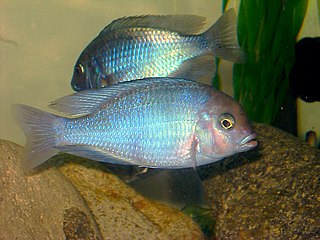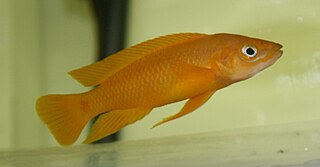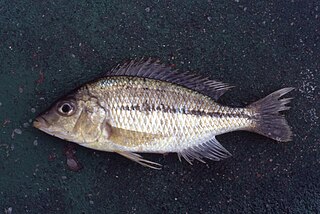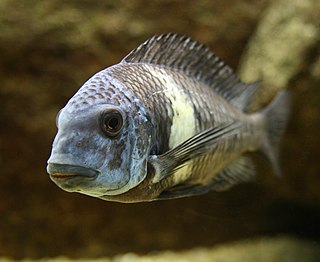
Maylandia estherae is a haplochromine cichlid. It is a rock dwelling fish or mbuna from Lake Malawi. This fish, like most cichlids from Lake Malawi, is a mouthbrooder - females hold their fertilized eggs then fry in their mouths until they are released after about 21 days.

Tropheus moorii is a species of cichlid endemic to Lake Tanganyika in Africa. Over 40 different color morphs of this species are dispersed throughout the lake, ranging from dark green to flame red and yellow. They mostly feed on filamentous algae on the rocky shallows they inhabit. T. moorii is a maternal mouthbrooder, so eggs are fertilized and young are carried in the mouth of the female while they hatch and develop.

Variabilichromis moorii has no common name and is a species of freshwater cichlid endemic to Lake Tanganyika in eastern Africa. It is a small ovate bodied fish named for an early collector of fish from the lake, John Edmund Sharrock Moore (1870-1947) who was a cytologist, zoologist and led an expedition to Lake Tanganyika and who discovered this species. Juveniles are usually yellow, and adults are dark brown to black in color. It reaches a total length (TL) of 10.3 centimetres (4.1 in). Currently it is the only member of its genus. V. moorii feeds on algae, zooplankton, and benthic invertebrates. It is also found in the aquarium trade.

Cyrtocara moorii, commonly known as the hump-head, is a species of haplochromine cichlid endemic to Lake Malawi in east Africa where they prefer areas with sandy substrates. It can grow to a length of 20 centimetres (7.9 in) TL. The species is popular among aquarium keepers where it is known as the hump-head cichlid, blue dolphin cichlid, Malawi dolphin or simply as moorii. It is currently the only known member of its genus. The specific name honours the English cytologist and biologist John Edmund Sharrock Moore (1870-1947).

Neolamprologus leleupi is a species of cichlid endemic to Lake Tanganyika where it occurs throughout the lake. It is a recess-dweller, inhabiting cracks and crevices. It feeds on invertebrates living in the rich biocover of the substrate. This species reaches a length of 10 centimetres (3.9 in) TL. The color of this fish ranges from bright yellow to deep brown. Both color variations exist at each location where this species is found. This relatively small cichlid is a substrate spawner. It is easily confused with the very similar N. longior a fish also endemic to Lake Tanganyika. The specific name honours the Belgian entomologist Narcisse Leleup (1912-2001), who collected the type.

Copadichromis borleyi is a species of haplochromine cichlid fish endemic to Lake Malawi in East Africa. The species is popular in the fishkeeping hobby where it is frequently kept in aquariums. The species has numerous common names, including redfin hap and goldfin hap.

Reganochromis calliurus is a species of cichlid endemic to Lake Tanganyika in East Africa. It lives over a sandy substrate in deeper coastal waters, to depths of at least 60 m (200 ft). Its preferred diet consists mostly of shrimp. It can reach a total length of 15 cm (5.9 in). This fish can also be found in the aquarium trade. It is currently the only known member of its genus.
Aristochromis christyi is a species of fish in the family Cichlidae, which is endemic to Lake Malawi in Africa. It is the only known member of its genus.

The nkhomo-benga peacock, also known as the new yellow regal peacock, is a species of haplochromine cichlid which is endemic to Lake Malawi. This species is threatened by capture for the aquarium trade.
Aulonocara gertrudae is a species of haplochromine cichlid which is endemic to Lake Malawi, being found in Malawi, Mozambique, and Tanzania. The habitat varies between populations, those south of the Ruhuhu River are sand dwellers which exploit the sandy muddy substrates found near river mouths, while those to the north of the Ruhuhu will occupy rocky habitats too. This is thought to be cause there are fewer rock inhabiting congeners north of the Ruhuhu. The territorial males of this species excavate a burrow in the sand or they may use a cavity formed in a rocky area, especially in the northern populations. The females are found in small foraging groups in the vicinity of the males. The specific name honours Konings' wife, Gertrude Dubin.

The giant cichlid, also known as the emperor cichlid, is a species of fish in the family Cichlidae, endemic to Lake Tanganyika in Africa. It is the only member of its genus Boulengerochromis and tribe Boulengerochromini.

Julidochromis marlieri is a species of cichlid endemic to Lake Tanganyika where it is only known from the northwestern portion preferring rocky shorelines in deep waters. In the aquarium trade, it is commonly known as Marlier's Julie, Spotted Julie or Chequered Julie. This species reaches a length of 15 centimetres (5.9 in) TL. Adult females are larger than adult males.

The convict julie is a cichlid species in the subfamily Pseudocrenilabrinae family endemic to Lake Tanganyika. Hence it is found in Burundi, the Democratic Republic of the Congo, Tanzania, and Zambia. The fish is named after Charles Tate Regan.

Limnotilapia dardennii, the latticed cichlid, is a species of cichlid endemic to Lake Tanganyika, where it prefers rocky areas near the coast. It may also be found in the aquarium trade. This species is currently the only known member of its genus.

Mastacembelus moorii is a species of fish in the family Mastacembelidae. It is endemic to Lake Tanganyika where it is a secretive species hiding among rocks or in the sediment in the littoral zone. It grows to a total length of 44 centimetres (17 in). The specific name honours the leader of an expedition to Lake Tanganyika, the biologist John Edmund Sharrock Moore (1870-1947).

Protomelas kirkii is a species of cichlid endemic to Lake Malawi where it is most commonly found in areas vegetated with Vallisneria. This species can reach a length of 18 centimetres (7.1 in) TL. This species can also be found in the aquarium trade.

The redbreast tilapia is a species of fish in the family Cichlidae. It is found widely in the southern half of Africa. Its natural habitats are freshwater lakes and freshwater marshes. It is known as the redbreast kurper in South Africa.
Tropheus brichardi is a species of cichlid endemic to Lake Tanganyika where it is found in areas with substrates of solid rock in the central portion of the lake. This species can reach a length of 10 cm (3.9 in). It can be found in the aquarium trade. The specific name honours Pierre Brichard (1921–1990) the aquarium fish exporter who provided the authors with the type.

Tropheus duboisi, the white spotted cichlid, is a species of cichlid endemic to Lake Tanganyika. It can reach a length of 12 cm (4.7 in).

Xenotilapia papilio is a species of cichlid endemic to Lake Tanganyika in East Africa. It is found on the western shore of the lake, between Tembwe (Deux) and Kanoni in the Democratic Republic of the Congo. It prefers deeper, rocky habitats, especially where the rocks are covered with sand, at depths from 3–40 m (9.8–131.2 ft).


















